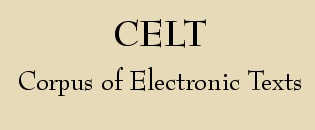CELT, the Corpus of Electronic Texts, is based in the History Department, University College Cork. This internet-based corpus of the primary sources of History and Irish Studies in Irish, English, Latin, and French with 11 million words of text is freely available, and growing. The texts are encoded in SGML/XML, the accepted industry standard.
CELT's texts are a invaluable resource, nationally and internationally, for teachers, students and researchers in Irish Studies and History. They are widely used in universities in Ireland and abroad. No other Irish university has a comparable internationally recognised textual project. Tens of thousands of webpages worldwide have linked to our texts.
Through the sub-project Linking Dictionaries and Texts (LDT) funded by the Irish Higher Education Authority (HEA), CELT collaborates with the University of Ulster at Coleraine. There, under the auspices of another project, the RIA's Dictionary of Old and Middle Irish (eDIL) has been digitised and XML-encoded. This project was funded by the UK's Arts and Humanities Research Board. It covers the period 700-1700 and was launched on 27 June 2007 in the Royal Irish Academy. Go to the DIL.
Linking Dictionaries and Texts was established so that the tens of thousands of citations in the eDIL can be linked to their sources in CELT's texts. Their full context, and translations (where available) will be given. This will save researchers long research trips. Instead they will be able to check the citations on their own PC. At CELT, researcher Dr Julianne Nyhan has designed a program to automate the creation of remote links between a given work cited in eDIL and the corresponding text on CELT. However, completion of this has been delayed.
The second element of this project has been to make available another 2 million words of Irish texts from c.800-1650, especially from texts cited frequently in eDIL, to maximise usefulness of the links. This target was reached by September 2006. Besides, we have received even more texts from our partners in Coleraine and will add them in due time, too.
Julianne has also compiled a Lexicon of Medieval Irish, which will become available on the CELT website incrementally in 2007. For a prototype, go to the Lexicon. CELT users will be able to highlight an Irish word in an Old or Middle Irish text, click on a button on the toolbar and look up the highlighted word—with examples, translations and usage. The Lexicon's structured information will also enable users to analyze its content in a customized way. Word formation and morphology in Old and Middle Irish are very complex, and can leave learners often in despair. The Lexicon is designed to aid users in locating a word under any of its many possible forms. Scholars will find that the Lexicon's support of English-Old Irish searches represents a major advancement on the current research infrastructure. In time, this lookup mechanism will also be extended to other projects within CELT, such as the Digital Dinneen.

